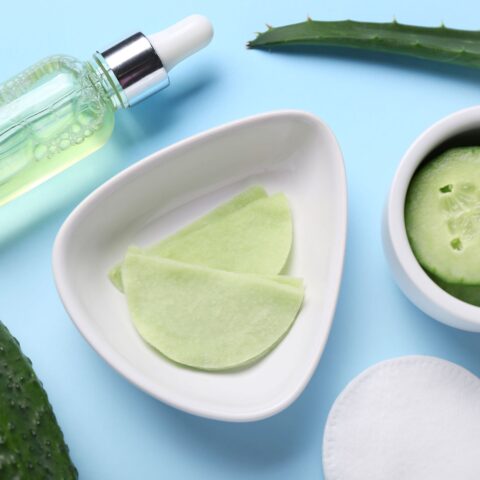Spooky Ingredients to Watch Out for in Candy

Preaching the ill effects of sugary sweets is old news, but did you know eating candy can have lethal consequences? In 2020, a Massachusetts man died of a potassium deficiency and two women years prior were admitted to hospitals for hypertension and muscle pains. [1,2,3] The culprit? Black licorice. Granted, all patients had been eating multiple bags of licorice for days or weeks straight, but the chemical in which licorice gets its flavor from has been proven to cause adverse health effects such as swelling and numbness if consumed too much.
We believe everything in moderation at The Paleo Diet®, so while we hope your candy consumption does not border on such extremes, a little indulgence every now and then won’t be detrimental to your health either. Here, we have a list of unhealthy ingredients in candy to watch out for if you do choose to consume some, and healthier alternatives to try if you’d rather steer clear completely.
The Scary News: Unhealthy Ingredients in Candy
We know sugar isn’t good for us, and many popular candies contain common allergens such as milk, soy, and nuts. But there are other potentially dangerous ingredients to watch out for.
Preservatives
- Synthetic antioxidants are used in many processed foods and cosmetic products to extend shelf life. In a 2022 study, researchers found tert-butylhydroquinone (tBHQ) led to an increased risk of respiratory infection from viruses such as influenza and Sars-CoV-2 (AKA COVID-19). [4] Other studies have shown an increased risk of food allergies. [5] Meanwhile, excessive use of butylated hydroxytoluene (BHT) may cause cancer as well as cell or DNA damage. [6] Some have categorized it as an endocrine disruptor, but studies have not found this to be true. [7]
- Hydrogenated oils are liquid oils that have been chemically altered into solids. In 2020, the U.S. Food & Drug Administration banned partially hydrogenated oils from use in food products due to the harmful effects of trans fatty acids, but fully hydrogenated oils are still approved for use. Though this other version does not contain trans fats, it is still high in saturated fats, which can contribute to cardiovascular disease if consumed in high amounts. [8]
Sweeteners
- High-fructose corn syrup (HFCS). Of all the chemical names in this list, this one is probably the most familiar for its prevalence in both sweet and savory foods. HFCS is processed corn starch that has had some of its glucose converted into fructose. There is substantial evidence pointing toward its increased risk of obesity, metabolic syndrome, kidney disease, and GI diseases such as colorectal cancer and colitis. [9] Unfortunately, because it is cheaper and sweeter than table sugar, this additive is found in many products.
- Artificial sweeteners cover a broad range of additives, but generally, they tend to be many more times sweeter than table sugar and low to zero calorie. Like HFCS, their potent sweetness and low calories make them an attractive additive for food manufacturers, but can lead to adverse health effects if overconsumed—like an increased risk in cancer. [10] Be on the lookout for the most common artificial sweeteners: sucralose, aspartame, and acesulfame-K.
Food Colorants/Dyes
- Titanium dioxide (TiO2) is known to reflect UV light and is used in sunscreens and light-sensitive packaging. It’s also known as “titanium white” for its natural white color and use as a brightening agent. Numerous studies have found that this mineral can accumulate in the body and lead to DNA damage, hormonal disruption, intestinal inflammation, cardiovascular tissue lesions, and increased anxiety. [11]
- Synthetic dyes. In 2021, the California Environmental Protection Agency’s Office of Environmental Health Hazard Assessment released a report stating that synthetic dyes led to hyperactivity and other neurobehavioral difficulties in children. [12] The most consumed dyes are Red No. 40, Yellow No. 5, and Yellow No. 6—all of which are approved in the U.S. and Europe, but the EU requires a warning label on foods containing these dyes.
The Good News: Candy Is Getting Less Unhealthy
Though larger governing bodies like the FDA and EU may be slow to update the status of dangerous additives, we’re seeing changes on a smaller scale that can have ripple effects. France temporarily banned the use of titanium dioxide in food processing in 2020, even though the FDA and EU still mark the substance as safe. And a class action lawsuit was filed against several candy manufacturers in 2022, alleging the companies had knowledge of the harmful effects of TiO2 for years. [13]
In 2023, California banned four ingredients found in candies and other processed foods with the passing of the California Food Safety Act. [14] Beginning in 2027, manufacturers will no longer be allowed to include the following additives in their food processing:
- Brominated vegetable oil
- Potassium bromate
- Propylparaben
- Red dye No. 3
Unfortunately, TiO2 was included in the first version of the Act but was subsequently removed. Still, this legislation is a huge step forward, as the state’s mandate will cause food producers to remove these ingredients from their products that are sold across the United States. Some brands like PEEPS have already started the process of phasing out Red No. 3 as early as 2024.
Though this progress in the U.S. and Europe shows promise, there are still many mysterious and frightening ingredients to be found in candies. If you’d rather play it safe and skip out on the candy entirely this Halloween—or next Valentine’s or Easter—there are many healthy alternatives to indulge in.
How to Have a Healthy Halloween
If you still like entertaining trick-or-treaters, consider handing out candy-free goodies to kids who come to your door or at the next trunk-or-treat. Things like fidget spinners, stickers, or temporary tattoos are a few fun, additive- and allergen-free alternatives to try—and they may land better with both kids and parents than pieces of fruit or homemade sweets that strangers may not trust.
For your own household and friends, there are many options for satisfying your sweet tooth while being 100% Paleo. Dates or homemade Fruit Roll-Ups can replace that sweet, gummy texture; and for chocolate lovers, banana slices dipped in melted cacao make for a quick treat, or a fruity chocolate bark. If you have a little more time on your hands, you can make Pomegranate Cocoa Treats that look just like chocolate truffles.
If you’re looking for a little more flexibility in your sweets that still align closely with The Paleo Diet guidelines, try Almond Shortbread Cookies or Sweet Potato Brownies for some healthy, shareable baked goods. With a fun mold, these Pomegranate Raspberry Gummies or Halloween Gummies make the perfect replacement for gummy bears. Decadent Turmeric Truffles or Dark Chocolate Raspberry Truffles with the right presentation will look better than any store-bought chocolate box. For a fun activity with the kids, make some Hot Chocolate Bombs to have after their Halloween festivities are over.
Whether you choose to break out the candy for Halloween or find healthier alternatives instead, we hope you’re able to enjoy the holiday either way. The most important aspect of eating healthy is making sure to find the right balance and not go to extremes of eating one food too much or completely denying yourself. So break out the chocolate (Paleo or otherwise) and have a Happy Halloween!
REFERENCES
- Too much candy: Man dies from eating bags of black licorice [Internet]. AP News. 2020 [cited 2023 Oct 27]. Available from: https://apnews.com/article/health-featured-us-news-oddities-licorice-04cf918055b735ea69483dd00e281253
- Ottenbacher R, Blehm J. An Unusual Case of Licorice-Induced Hypertensive Crisis. South Dakota Medicine: The Journal of the South Dakota State Medical Association [Internet]. 2015 Aug 1 [cited 2023 Oct 27];68(8):346–7, 349. Available from: https://pubmed.ncbi.nlm.nih.gov/26380428/
- Shah M, Williams C, Aggarwal A, Choudhry WM. Licorice-related rhabdomyolysis: a big price for a sweet tooth. Clinical Nephrology. 2012 Jun 1;77(06):491–5.
- Németh K, Petschner P, Pálóczi K, Fekete N, Pállinger É, Buzás EI, et al. Chronic Exposure to the Food Additive tBHQ Modulates Expression of Genes Related to SARS-CoV-2 and Influenza Viruses. Life [Internet]. 2022 Apr 26 [cited 2023 Apr 7];12(5):642. Available from: https://www.ncbi.nlm.nih.gov/pmc/articles/PMC9147452/
- Research links TBHQ to allergies | Food Business News | July 25, 2016 20:27 [Internet]. www.foodbusinessnews.net. [cited 2023 Oct 27]. Available from: https://www.foodbusinessnews.net/articles/8349-research-links-tbhq-to-allergies
- Xu X, Liu A, Hu S, Ares I, Martínez-Larrañaga MR, Wang X, et al. Synthetic phenolic antioxidants: Metabolism, hazards and mechanism of action. Food Chemistry. 2021 Aug;353:129488.https://www.foodbusinessnews.net/articles/8349-research-links-tbhq-to-allergies
- https://www.sciencedirect.com/science/article/abs/pii/S0308814621004945?via=ihub De Abrew KN, Natoli T, Lester CC, Wang X, Shobair M, Subramanian A, et al. A New Approach Methodology (NAM) Based Assessment of Butylated hydroxytoluene (BHT) for Endocrine Disruption Potential. Toxicological Sciences. 2022 Sep 26;190(2):227–41.
- List of Fully Hydrogenated Oils [Internet]. LIVESTRONG.COM. Available from: https://www.livestrong.com/article/188137-list-of-fully-hydrogenated-oils/
- Johnson DA. “Sickeningly Sweet”…. High-Fructose Corn Syrup-Caveat Emptor!. American Journal of Gastroenterology. 2021 Jun 7;Publish Ahead of Print.https://www.livestrong.com/article/188137-list-of-fully-hydrogenated-oils/
- Debras C, Chazelas E, Srour B, Druesne-Pecollo N, Esseddik Y, Szabo de Edelenyi F, et al. Artificial sweeteners and cancer risk: Results from the NutriNet-Santé population-based cohort study. Zheng W, editor. PLOS Medicine [Internet]. 2022 Mar 24;19(3):e1003950. Available from: https://journals.plos.org/plosmedicine/article?id=10.1371/journal.pmed.1003950
- Racovita AD. Titanium Dioxide: Structure, Impact, and Toxicity. International Journal of Environmental Research and Public Health [Internet]. 2022 May 6;19(9):5681. Available from: https://pubmed.ncbi.nlm.nih.gov/35565075/
- Ca.gov. 2023. Available from: https://oehha.ca.gov/risk-assessment/press-release/report-links-synthetic-food-dyes-hyperactivity-and-other
- Frightening food: The scary additives lurking in Halloween candy | Environmental Working Group [Internet]. www.ewg.org. Available from: https://www.ewg.org/news-insights/news/2022/10/frightening-food-scary-additives-lurking-halloween-candy https://oehha.ca.gov/risk-assessment/press-release/report-links-synthetic-food-dyes-hyperactivity-and-other
- MSN [Internet]. www.msn.com. [cited 2023 Oct 27]. Available from: https://www.msn.com/en-us/news/other/california-moves-ahead-of-the-fda-in-banning-common-candy-additives/ar-AA1iv2xp https://www.ewg.org/news-insights/news/2022/10/frightening-food-scary-additives-lurking-halloween-candy
Andrea Dehnke
Andrea is the Content Manager at The Paleo Diet and has experience working with several health and nutrition publications.
More About The Author



